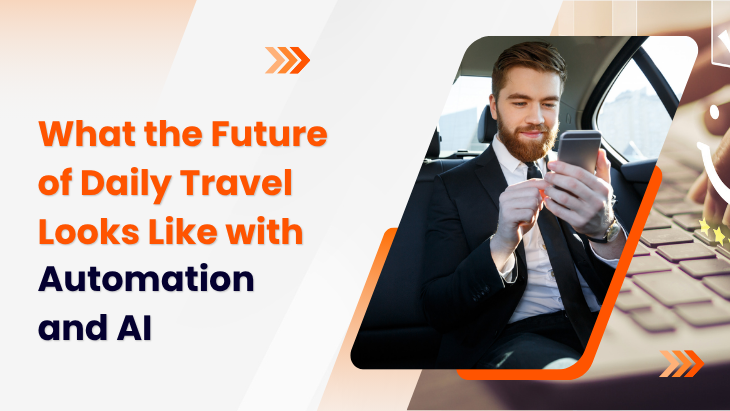What the Future of Daily Travel Looks Like with Automation and AI

Posted on: 29 July, 2025
As we step into a new era of transportation, automation and AI are no longer futuristic concepts; they're becoming a part of our daily lives. Simplifying Your Daily Commute From smart traffic signals to predictive navigation apps, artificial intelligence is reshaping the way we move through cities. The future of daily travel promises convenience, efficiency, and fewer headaches, all while simplifying your daily commute. With increasing urban populations and complex traffic patterns, AI offers scalable solutions that traditional infrastructure simply cannot keep up with.
Smart Mobility: A Shift from Ownership to Access
One of the most noticeable transformations driven by automation and AI is the gradual shift from vehicle ownership to mobility as a service (MaaS). Instead of owning a car, people are beginning to rely on AI-powered ride-sharing platforms, autonomous shuttle services, and subscription-based transport models. This shift not only reduces traffic congestion but also simplifies your daily commute by offering reliable, on-demand options tailored to real-time conditions. AI analyzes traffic, rider demand, and road conditions to send the best vehicle at the right time, optimizing every leg of the journey.
AI in Public Transport: Personalized and Predictive
Public transportation systems across the globe are undergoing a quiet revolution, driven by the power of AI. Buses, metros, and trains are becoming smarter, with AI predicting delays, managing schedules, and offering personalized alerts to passengers. Imagine getting a notification before you leave your house saying the train is running three minutes late—that’s the kind of real-time convenience automation brings. With these tools, simplifying your daily commute becomes less about adjusting to the system and more about the system adjusting to you.
Autonomous Vehicles: The Road Ahead
Despite being in the testing phase in many places, self-driving cars have the potential to revolutionize commuting. These vehicles use a combination of sensors, machine learning, and real-time data to navigate roads without human intervention. They promise not just comfort and safety, but also a major reduction in traffic accidents caused by human error. In the future, your daily commute might involve a driverless pod that picks you up at your doorstep, drops you off at your workplace, and parks itself. The integration of autonomous vehicles will undoubtedly simplify your daily commute, making it safer and less stressful.
AI-Powered Traffic Management Systems
One of the most frustrating aspects of urban travel is congestion, but AI offers a solution. Cities around the world are already adopting intelligent traffic management systems that monitor road usage in real time. These systems adjust signal timings based on actual traffic flow, redirect vehicles away from congestion hotspots, and even communicate with connected cars to offer alternate routes. With this level of dynamic response, AI is not just simplifying your daily commute—it’s re-engineering how traffic behaves on a city-wide scale.
Seamless Integration of Multimodal Travel
The future of commuting won’t rely on just one mode of transport. Instead, we’ll see an interconnected web of transit options—from bikes and buses to trains and autonomous taxis—all working together. AI plays a crucial role in stitching these systems into a seamless journey. Imagine a single app that plans your entire route, books your seats, syncs with your calendar, and adjusts in real time if you’re running late. This level of automation simplifies your daily commute by taking the guesswork out of planning and letting AI handle the logistics.
Reducing Environmental Impact Through Smart Commuting
AI and automation aren’t just about convenience—they’re also key to building more sustainable cities. By optimizing routes and managing vehicle usage, these technologies help reduce fuel consumption and emissions. Ride-sharing algorithms ensure fewer cars on the road, while electric autonomous vehicles contribute to lower pollution levels. Simplifying your daily commute with AI also means doing your part for the environment, as these systems aim to balance mobility with ecological responsibility.
The Role of AI in Workplace Commutes
For many, commuting to work is the most significant part of daily travel. AI is now being used by companies to help employees get to the office more efficiently. Corporate shuttle services are powered by algorithms that determine the best pickup points, route combinations, and timing based on employee data. Some offices even sync their start times with real-time traffic conditions. This workplace integration simplifies your daily commute by aligning personal and organizational needs through data-driven decision-making.
Challenges and Ethical Considerations
Despite the many benefits, the rise of AI in travel raises important questions. How will automation impact jobs in transportation? How can we ensure data privacy and protect against system failures or hacks? While these technologies simplify your daily commute, they also demand robust regulation and ethical frameworks to ensure they are inclusive and secure. Addressing these challenges now is crucial to building public trust and ensuring a smooth transition to AI-powered transportation.
Conclusion
As automation and AI continue to advance, the future of daily travel will become more personalized, predictable, and planet-friendly. Trip-Tie Whether it’s through autonomous vehicles, smart traffic systems, or multimodal journey planning, these innovations are all aimed at one goal: simplifying your daily commute. The days of waiting for buses without updates, getting stuck in traffic without alternatives, or juggling multiple apps for your journey are rapidly coming to an end. What lies ahead is a smarter, simpler, and more connected commute powered by the intelligence of machines and the vision of innovation.


